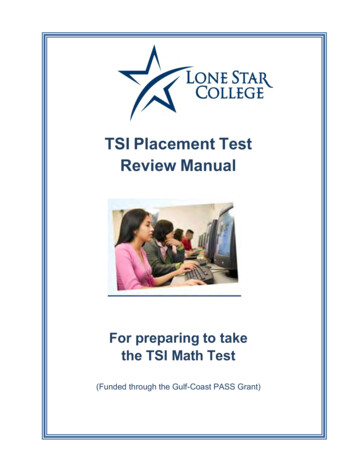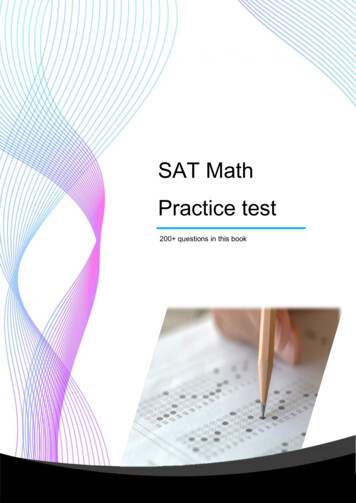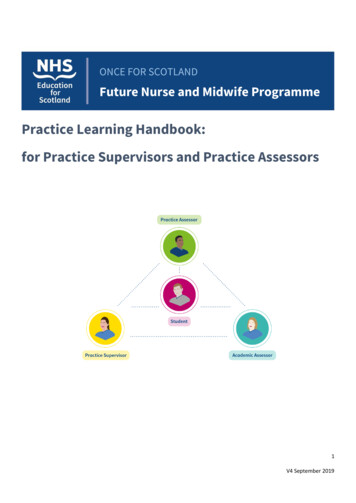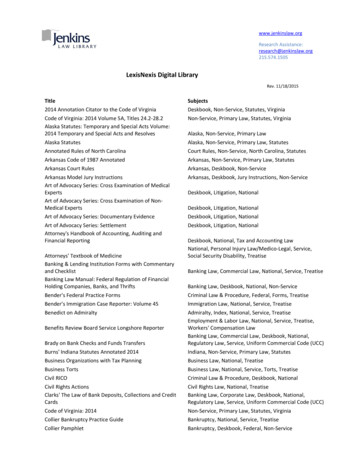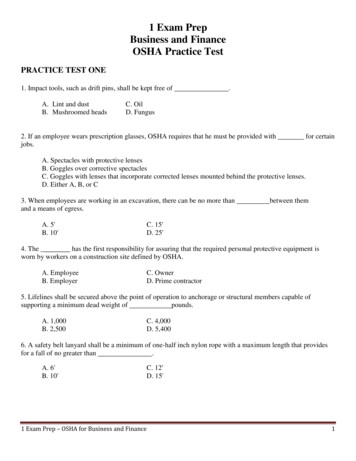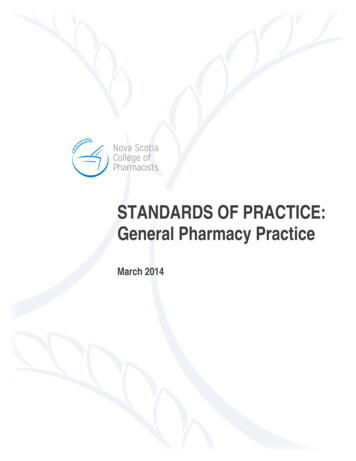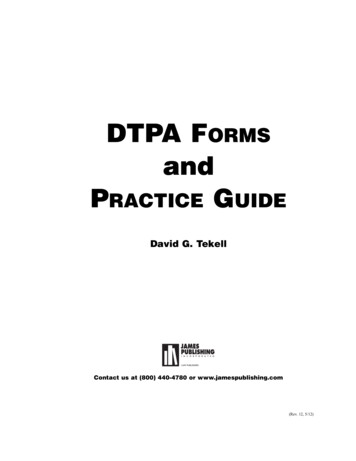
Transcription
DTPA FORMSandPRACTICE GUIDEDavid G. TekellContact us at (800) 440-4780 or www.jamespublishing.com(Rev. 12, 5/12)
DTPA FORMSandPRACTICE GUIDECopyright 1989 - 2012James Publishing, Inc.ISBN 1-58012-010-5All rights reserved.This publication is intended to provide accurate and authoritative information about the subjectmatter covered. It is sold with the understanding that the publisher does not render legal or other professional services. If legal advice or other expert assistance is required, seek the services of a competent professional.Persons using this publication in dealing with specific legal matters should exercise their ownindependent judgment and research original sources or authority and local court rules.The publisher and the author make no representations concerning the contents of this publication and disclaim any warranties of merchantability or fitness for a particular purpose.We view the publication of this work as the beginning of a dialogue with our readers. Periodicrevisions to it will give us the opportunity to incorporate your suggested changes. Call us at (714)755-5450 or send your comments to:Revision EditorJames Publishing, Inc.3505 Cadillac Ave.Suite HCosta Mesa, CA 92626STAFFManaging Editor: Lisa Dunne, Esq.Production Editor: Rebecca ArandaProduction:Rebecca ArandaAmanda WinklerF-2
About the AuthorDAVID G. TEKELL(J.D., University of California—Hastings College of the Law,1986; B.S. Business Administration, University of SouthernCalifornia, 1983.)Mr. Tekell is a practicing trial lawyer and an Adjunct Professorat Baylor University School of Law where he teaches ConsumerProtection. He has over 25 years of experience handling consumer law cases on both sides of the docket. After interning withChief Judge Walter S. Smith, Jr. of the United States DistrictCourt for the Western District of Texas, Waco Division during hislast semester of law school in 1986, Mr. Tekell worked withWaco’s largest defense firm, trying cases in both federal and statecourts. In 1987, Mr. Tekell defended one of the first “vanishingpremium” life insurance fraud cases filed in Texas. In 1990, hebegan handling “vanishing premium” life insurance fraud casesfrom the plaintiff’s side. In 1995, he represented the plaintiffs in the landmark case of Ferguson v.Crown Life Insurance Company, which resulted in one of the largest consumer law verdicts everissued in Travis County at the time. That case was subsequently appealed and reported as CrownLife Ins. Co. v. Casteel, 22 S.W.3d 378 (Tex. 2000).From 1996 to 2005, Mr. Tekell served as co-lead class counsel in several national class actionsagainst life insurance companies for “vanishing premium” life insurance sales practices and leadclass counsel against other national companies for deceptive trade practices. He has been a frequent author and speaker on life insurance sales practices and class action litigation. Throughouthis career, Mr. Tekell has maintained an active docket of individual consumer law cases, tryingmany of them to jury verdicts. He is board certified in Consumer and Commercial Law (2004) andin Personal Injury Trial Law (2004) by the Texas Board of Legal Specialization. Currently, Mr.Tekell is managing partner of the law firm Tekell & Atkins, L.L.P. in Waco, Texas.F-3(Rev. 12, 5/12)
Past AuthorsDAVID F. BRAGG(J.D., cum laude Baylor University School of Law, 1974).For eight years, Mr. Bragg served as an Assistant Attorney General of Texas and then Chiefof the Attorney General’s Consumer Protection and Antitrust Division. Mr. Bragg was a coauthor of Texas Consumer Litigation (1st and 2nd Editions). In addition to authoring numerous articles on various legal subjects and three State Bar video tapes on trial practice, Mr.Bragg has served as Chairman of the State Bar’s Consumer Law Section and is a formerPresident of Texas Consumer Association. In 1991, Mr. Bragg was appointed by Governor AnnRichards to be her “Citizen Trustee” on nursing homes and authored a report entitled, Make TexasA Good Place to Grow Old. Mr. Bragg frequently serves as a faculty member of the State Bar ofTexas and University of Texas Continuing Legal Education programs and lectures throughout theState on subjects related to trial strategy, nursing home abuse and neglect and deceptive trade practices litigation. Mr. Bragg has been in private practice since 1981 and is a member of the firm ofBragg Chumlea McQuality, with offices in Austin and Dallas.MICHAEL CURRY(J.D., with honors, University of Texas School of Law, 1976).Following graduation from law school, Mr. Curry served as a briefing attorney for theSupreme Court of Texas. He was then appointed an Assistant Attorney General of Texas in theConsumer Protection and Antitrust Division until he entered private practice in 1979. Mr. Curryhas served as Chairman of the State Bar of Texas Consumer Law Section, and as an AdjunctProfessor of Law at the University of Texas School of Law since 1985. Mr. Curry was the Editorof TEXAS CONSUMER LITIGATION (2nd Edition), has authored numerous law review and continuing legal education articles on subjects related to deceptive trade practices, Insurance Code litigation, negotiation and ADR.Mr. Curry, a full-time professional mediator, has mediated over 2,000 cases across the State,including complex personal injury, construction, DTPA, malpractice, insurance, employment andregulatory disputes. He has been recognized as an AAM Certified Advanced Mediator. He is amember of the Association of Attorney-Mediators and the Association for Conflict Resolution. Heis a Fellow of the Center for Public Policy Dispute Resolution. He is on the approved mediatorlists for the federal district courts in the Western District of Texas (Austin, San Antonio, El Paso,Waco) and for the state district courts in Austin and San Antonio. He maintains a web site atwww.mcmediate.com.F-4
IntroductionIn 1989, the Consumer Law Section of the State Bar of Texas conducted a survey of thirty-fourcounties to obtain data on jury trials involving the Texas Deceptive Trade Practices—ConsumerProtection Act (DTPA).1 The survey found, among other things, that of the 5,466 jury trials conducted in a three year period in the survey area, 695 of the trials involved claims under the DTPA.In other words, the DTPA was involved in 13% of all jury trials. When the vast number of othercauses of action are considered, this result was and is astounding. Clearly, if an attorney was involvedin litigation and had not handled a DTPA case yet, it was only a matter of time before a DTPA clientknocked on the door.The 74th Texas Legislature, meeting in Regular Session until it was gavelled to a close inMay 1995, enacted sweeping changes in many laws which were designed to provide a remedyfor victims of wrongful conduct. The proponents of the tort reform movement held the beliefthat these laws favored plaintiffs to such a degree that the defendants in such lawsuits weredenied a “level playing field.” The opponents of tort reform, who uniformly insisted on puttingthe words “tort reform” in quotes, were of the opinion that the playing field not only was level,but that changes in the Justices on the Supreme Court in recent years had tilted the field verymuch in favor of defendants.The DTPA and Article 21.21 of the Insurance Code were among those laws that the proponentsof tort reform sought to change. Political power clearly had shifted in favor of the proponents withthe election of a Governor who ran on a tort reform platform as well as the defeat in the legislature of several of its more outspoken consumer advocates. Early in the legislative session, it wasclear that there would be changes in the DTPA and Article 21.21; the only question was how extensive the changes would be.The Lieutenant Governor and Speaker of the House convened an ad hoc committee of members of the House and Senate, business community and consumer advocates to discuss anddebate proposed changes to both the DTPA and Article 21.21. The authors were participants inmany of the numerous meetings that were held. Although some compromises were reached, onbalance, the final product of the committee’s work, and then that of the legislature, was anamendments package that imposes significant new requirements and limitations on those whoare victims of deception or unfairness in consumer transactions.The language of the 1995 amendments to the DTPA and Article 21.21 reflect the give and takeof negotiations between lobbyists, advocates and members of the legislature. The effect of theamendments is immediate. The new venue rules already are in effect, as of September 1, 1995; andall of the amendments apply to all causes of action that accrue after September 1, 1995, as well asall lawsuits that are filed after September 1, 1996, regardless of when the causes of action accrued.Survey of Jury Trials Under the Deceptive Trade Practices Act, Consumer Law Section, StateBar of Texas, March 21, 1989.1F-5(Rev. 12, 5/12)
It is also clear that the changes in existing law are extensive. The amendments touch nearlyevery aspect of DTPA and Insurance Code litigation, from the content of the initial pre-filingnotice letter and its response, to the type and amount of damages a jury may award. The amendments even include an entirely new section in both the DTPA and Article 21.21 on mediation. Theamendments change features of the DTPA which, since its enactment in 1973 have been sacrosanct, e.g. the DTPA can now be waived in specified circumstances; if a transaction exceeds 500,000, the DTPA no longer applies; and “professionals” (undefined) are given special statusand protection against DTPA lawsuits.The purpose of this volume is to provide an up-to-date, handy source book for handling DTPAlitigation whether as a plaintiff or a defendant. It would be impossible for any single volume to contain all one needs to know about handling a DTPA case. The forms and practice guides provide thebasics, thereby allowing additional time for more creative thinking about each case.There are many individuals who deserve special mention by the authors. Many of the ideasand concepts in this book are not original but have been gathered through the years from countless attorneys with whom the authors have come in contact. These individuals must, of necessity, go nameless for to list each and every person whose professional skills have influenced ourwriting would require a separate volume. We must, however, give special thanks to our familiesbecause it would be impossible to write any book, especially a law book, without their support.We also wish to thank Darlene B. Ellison, whose pleasant attitude and tireless work has enableus not only to publish this book, but also maintain a fulltime trial and mediation practice as well.Throughout this book, two citations are presented in abbreviated form: First, TEX. BUS. & COM.CODE §17.41 et seq., the Deceptive Trade Practices-Consumer Protection Act, is cited as “DTPA.”Second, Bragg, Maxwell, Longley, TEXAS CONSUMER LITIGATION 2D (1983) is cited as “TEXASCONSUMER LITIGATION 2D.”David F. BraggMichael CurryApril 1996Austin, TexasF-6
Table of ContentsChapter 1Initial Client Contacts (Plaintiff)Chapter 2Initial Client Contacts (Defendant)Chapter 3Giving Notice and Responding to an OfferChapter 4Responding to the NoticeChapter 5Plaintiff’s PleadingsChapter 6Defendant’s PleadingsChapter 7DiscoveryChapter 8Pre-Trial ProceedingsChapter 9Trial: Part One Voir Dire to Close of EvidenceChapter 10Trial: Part Two Court’s Charge to JudgmentF-7(Rev. 12, 5/12)
Expanded Table of ContentsChapter 1Initial Client Contacts (Plaintiff)§1.01 General Considerations§1.02 The Deceptive Trade Practices Act: An Overview§1.02.1Application and Effective Dates§1.02.2Construction of the DTPA§1.02.3Cumulative Remedies§1.02.3.1Limitations§1.02.4Plaintiff Must be a “Consumer”§1.02.4.1“Consumer” Defined§1.02.4.2Consumer Status of Intended and Incidental Beneficiaries§1.02.4.3Assignability of DTPA Claims§1.02.4.4Survival of Action Following Death of �1.02.7Who Can Be Sued?§1.02.7.1Good or Services Must Form Basis of Complaint§1.02.7.2“In Connection With” ional Services§1.02.7.3.2Personal Injury Claims§1.02.7.3.3Large Transactions Exemptions§1.02.7.4Preemption§1.02.7.5Real Estate Agents and Brokers§1.02.7.6Real Estate Inspectors§1.02.8Long-Term Care Providers§1.02.8.1Relationship Between DTPA and Negligence in Long-Term Care§1.02.8.2Recasting Causes of Action§1.02.8.3Statute of Limitations§1.02.8.4Expert Report§1.02.8.5Arbitration Agreements§1.02.8.6Limitations on Damages§1.02.8.7Assisted Living Facilities§1.02.8.8Types of Assisted Living Facilities§1.02.8.9Standards for Assisted Living Facilities§1.02.8.10 Gathering Information[a] FORM: Request for medical records[b] FORM: Request for other records[c] FORM: Open records request§1.02.9False, Misleading or Deceptive Acts or Practices§1.02.9.1“Mere Breach of Contract”§1.02.10 Implied Representations§1.02.11 Parol Evidence Rule InapplicableF-8
§1.02.12 “Knowing” and “Intentional” Violations§1.02.13 Breach of Warranty§1.02.14 Express Warranties§1.02.15 Implied Warranties§1.02.16 —New Home Construction§1.02.16.1 —Mold Litigation—Boom to Bust[a]TRIAL PLAN: Toxic Mold in Leased Apartment§1.02.17 ———Commercial Leasing/Construction§1.02.18 ———Services§1.02.19 ——No Implied Warranty Recognized§1.02.20 —Unconscionability§1.02.21 —Damages Under the DTPA§1.02.21.1 —Causation§1.02.22 ——Compensatory Damages§1.02.22.1 —Economic Damages§1.02.22.2 —Mental Anguish Damages for Conduct Committed Knowingly or Intentionally§1.02.23 ——Additional Damages§1.02.24 —Offset Necessary§1.02.25 —Combining Elements or Causes of Action§1.02.26 —Restitution Under the DTPA§1.02.27 —Attorney’s Fees§1.03 Chapter 541 of Texas Insurance Code§1.03.1Article 21.21 Recodified§1.03.2Broad Grounds for Private Cause of Action§1.03.3Unfair Settlement Practices as Grounds for Action§1.03.4Duty of Good Faith and Fair Dealing§1.03.5Misrepresentation of Insurance Policy§1.03.6Limitations§1.03.7The DTPA and Chapter 541 of the Texas Insurance Code§1.03.8Damages and Attorney’s Fees Under Chapter 541 of the Insurance Code§1.03.9Interpretation of Insurance Contracts Under Article 21.21§1.03.10 Other Statutory Causes of Action—Tie-in Statutes§1.03.10.1 Debt Collection Practices[a] FORM: Letter to creditor to end collection calls§1.03.11 ERISA§1.03.12 Attorney’s Fees and ERISA§1.04 Residential Construction Liability§1.04.1Residential Construction Commission Act [Historical]§1.04.1.1Continued Applicability of RCCA Warranties and Building Standards§1.04.1.2Third-Party Warranty Companies§1.04.2Residential Construction Liability Act§1.04.2.1Definitions and Scope of Coverage§1.04.2.2Affirmative Defenses Available to Contractor§1.04.2.3Notice and Offer of Settlement§1.04.2.4Consequences of Failing to Provide Inspection or to Accept a Settlement Offer§1.04.2.5Consequences of Failing to Make a Reasonable Settlement Offer or Initiate Repairs§1.04.2.6When Pre-Filing Notice Is Not Required§1.04.2.7Abatement and Dismissal§1.04.2.8Limitations on Damages§1.05 Initial Client Interview and Questionnaire[a] FORM: Letter setting appointment, enclosing questionnaire[b] FORM: Client questionnaire (plaintiff)F-9(Rev. 12, 5/12)
lists for Initial Interview[a] CHECKLIST: Purchase of new or used motor vehicle[b] CHECKLIST: Purchase of goods or services[c] CHECKLIST: Purchase of new residence[d] CHECKLIST: Purchase of raw land[e] CHECKLIST: Investments[f] CHECKLIST: Lender liability[g] CHECKLIST: Manufactured housing[h] CHECKLIST: Lease of commercial real property[i] CHECKLIST: Assisted living facilityContacting the Previous Attorney[a] FORM: Letter to previous attorneyConflicts of InterestAttorney–Client Contracts[a] FORM: Letter enclosing contract[b] FORM: Contingent fee agreement[c] FORM: Hourly agreementFee Division Agreements (including referral fees)[a] FORM: Client authorization for division of fee[b] FORM: Agreement to divide attorney’s fees (referring attorney)[c] FORM: Agreement to divide attorney’s fees (co-counsel)[Reserved]Beginning the Case[a] FORM: Letter—what to expect[b] FORM: Alternative paragraph (residential construction governed by RCLA and not RCCA)Chapter 2Initial Client Contacts (Defendant)§2.01 General Considerations§2.02 Defenses Available in DTPA Cases§2.02.1Common Law Defenses Do Not Apply§2.02.2Professional Services Exemption§2.02.3Real Estate Brokers and Agents Exemption§2.02.4Waiver/Superseding Cause[a] FORM: Waiver of consumer rights§2.02.5“As Is” Clause or Agreement§2.02.6Independent Investigation§2.02.7Statutory Defenses§2.02.8Media Exemption§2.02.9Contribution and Indemnity§2.02.10 Responsible Third Party§2.02.11 Settlement Credit§2.03 Client Questionnaire (Defendant)[a] FORM: Client questionnaire (defendant)§2.04 —Checklists for Initial Interview[a] CHECKLIST: Sale of goods or services[b] CHECKLIST: Sale of new residenceF-10
§2.05[c] CHECKLIST Sale of raw land[d] CHECKLIST: Lease of commercial real propertyAttorney-Client Agreements[a] FORM: Letter agreement with respect to legal services[b] FORM: Letter enclosing attorney-client agreement[c] FORM: Attorney-client hourly fee agreementChapter 3Giving Notice and Responding to an Offer§3.01§3.02§3.03General ConsiderationsNotice Letter: DTPA—Elements of a Notice Letter[a] FORM: Notice letter (general form)§3.04 —Products or Services[a] FORM: Notice letter: defective product (rescission and damages)[b] FORM: Notice letter: defective product or service (damages)§3.05 New Automobiles§3.06 Residential Construction[a] FORM: Notice letter to builder/seller[b] FORM: Notice letter to engineer, architect[c] FORM: Notice letter on a home warranty claim[d] FORM: Notice letter to real estate broker/agent§3.07 —When Pre-Filing Notice Is Not Required by RCLA§3.08 to §3.13 [Reserved]§3.14 —Investments and Business Opportunities[a] FORM: Notice letter: business opportunity§3.15 Raw Land Sales[a] FORM: Notice letter: no potable water on land[b] FORM: Notice letter: raw land in flood zone§3.16 Manufactured Housing[a] FORM: Notice letter: manufactured housing[b] FORM: Manufactured Homeowners’ Recovery Trust Fund claim[c] FORM: First demand for return of deposit[d] FORM: Second demand for treble deposit and attorney’s fees§3.17 Chapter 541 [formerly Article 21.21] of the Insurance Code[a] FORM: Notice letter: Chapter 541§3.18 Lease of Commercial Property§3.18.1Assisted Living Facilities[a] FORM: Notice letter to Assisted Living Facility§3.18.2—Notice and Authorization for Release of Healthcare Information[a] FORM: Notice letter to assisted living facility[b] FORM: Authorization for release of protected health information§3.19 Client Communications Concerning the Notice Letter[a] FORM: Letter to client transmitting notice letter[b] FORM: Letter to client: claim rejectedF-11(Rev. 12, 5/12)
§3.20Evaluating a Settlement Offer[a] FORM: Letter to client evaluating a settlement offer[b] FORM: Letter to client evaluating a settlement offer (residential construction)[c] FORM: Letter accepting the settlement offer[d] FORM: Letter accepting the offer to repair[e] FORM: Letter rejecting the settlement offer[f] FORM: Letter rejecting offer to repairChapter 4Responding to the 4.08§4.09§4.10§4.11Evaluating the Notice Letter[a] FORM: Letter requesting inspection of goods—Initial Evaluation of DTPA Notice Letter[a] FORM: Letter to client analyzing claim[b] FORM: Letter requesting additional time—Initial Evaluation of Residential Construction Notice Letter[a] FORM: Letter requesting opportunity to inspect and photograph defects[b] FORM: Letter to builder analyzing the notice letter—Notice to Subcontractors[a] FORM: Letter to subcontractor giving notice of claimRequesting Additional Information[a] FORM: Letter requesting additional information (general)[b] FORM: —Alternative questions: residential construction defectsResponding to the Notice Letter[a] FORM: General statement denying liability—Offering the Full Amount[a] FORM: Offer of settlement: full amount of claim—Offering Less Than the Amount Sought[a] FORM: Offer of settlement: less than the amount sought—Offer to Repair Construction Defects[a] FORM: Offer of settlement: repair of construction defects[b] FORM: Offer of settlement: pay for repairsRejecting the Claim[a] FORM: Letter rejecting claim—Effect of Consumer’s Rejection of Settlement Offer[a] FORM: Affidavit of rejection of settlement offerChapter 5Plaintiff’s Pleadings§5.01§5.02§5.03Contents of PetitionOriginal Petition[a] FORM: Petition (general form)CitationF-12
§5.04§5.05—The Function of Pleadings—Service of Citation on Individuals and Partnerships[a] FORM: Citation on individual[b] FORM: Citation on general partnership[c] FORM: Citation on limited partnership (service on registered agent)§5.06 —Service of Citation on Corporations and Insurance Companies[a] FORM: Service on Texas corporations[b] FORM: Service on Texas insurance company§5.07 —Service on the Secretary of State[a] FORM: Citation on Secretary of State—no agent for service[b] FORM: Citation on Secretary of State—engages in business in Texas[c] FORM: Citation on Secretary of State—former resident[d] FORM: Citation on Secretary of State—claim arises from business§5.07.1—Service on the Commissioner of Insurance[a] FORM: Citation on Commissioner of Insurance—non-admitted insurer doing business in Texas§5.08 —Long Arm Jurisdiction[a] FORM: Citation based on long arm jurisdiction§5.09 —Obtaining proof of service§5.10 —Citation on Person in Charge of Business[a] FORM: Citation when currently engaged in business[b] FORM: Notice of service to nonresident§5.11 —Service on Certain Employees or Agent§5.12 Alleging Statutory Authority§5.13 Notice and Conditions Precedent[a] FORM: —Notice given[b] FORM: —Notice not given§5.14 Venue[a] FORM: —General venue[b] FORM: —DTPA venue[c] FORM: —Breach of warranty by manufacturer[d] FORM: —Venue proper as to other defendant§5.15 Knowing Conduct[a] FORM: —Knowing conduct (general form)[b] FORM: —Knowing conduct (breach of warranty)§5.15.1Intentional Conduct[a] FORM: —Intentional conduct (general form)[b] FORM: —Intentional conduct (breach of warranty)§5.16 Economic Damages[a] FORM: —Economic damages (product)[b] FORM: —Economic damages (unimproved land)[c] FORM: —Economic damages (residential construction)[d] FORM: —Economic damages (investment)§5.17 Additional Statutory Damages; Exemplary Damages[a] FORM: —Additional damages (personal injury; wrongful death)[b] FORM: —Exemplary damages§5.18 Pleading Specific Actions[a] REFERENCE TABLE OF CAUSES OF ACTION AND REMEDIES§5.19 —New Automobile[a] FORM: New automobile (with holder-in-due-course Rule claim)F-13(Rev. 12, 5/12)
§5.19.1—Misrepresentation in Sale of Business Goods[a] FORM: Business goods§5.20 —Sale of Unimproved Land[a] FORM: —Unimproved land§5.21 Purchase of a New Residence[a] FORM: New house purchased from builder/seller (TRCCA compliance and warranties)§5.21.1Purchase of a Used Residence[a] FORM: Used house purchased from owner (failure to disclose defects)[b] FORM: Used house, suit against real estate broker[c] FORM: Used house, suit against real estate inspector§5.21.2Commercial Construction[a] FORM: Defective commercial construction§5.22 Real Estate Funds to Satisfy Judgments§5.23 —Real Estate Recovery Trust Account§5.24 —Real Estate Inspector Recovery Fund[a] FORM: Motion for order directing payment out of Real Estate Recovery Trust Account[b] FORM: —Affidavit of custodian of official records, Texas Real Estate Commission[c] FORM: Order directing payment out of Real Estate Recovery Trust Account§5.25 —Investments[a] FORM: Investments (general)[b] FORM: —Franchise investment[c] FORM: —Purchase of existing franchise§5.26 —Banking, Lending[a] FORM: Unauthorized withdrawal of funds[b] FORM: —False representation to extend credit§5.27 —Manufactured Housing[a] FORM: —Manufactured home defects in workmanship and repairs§5.28 —Commercial Real Property Lease[a] FORM: —Commercial lease of real property§5.28.1—Chapter 541 of the Texas Insurance Code[a] FORM: —Petition (Insurance Code Chapter 541)§5.28.2—Breach of Ambiguous Insurance Contract[a] SAMPLE: —Petition asserting ambiguity, breach of contract and Chapter 541 violations§5.28.3Assisted Living Facilities[a] FORM: Petition (Assisted Living Facility)§5.29 Application for Injunctive Relief[a] FORM: —Petition for injunctive relief (general form)[b] FORM: —Temporary restraining order (general form)[c] FORM: —Application for temporary injunction (threatened foreclosure)[d] FORM: —Temporary injunction§5.30 Pleading Discovery Rule to Avoid Limitations[a] FORM: —Allegation invoking the discovery rule§5.31 Petition for Unfair Debt Collection Practices[a] FORM: Petition for unfair debt collection practices[b] FORM: Petition against bank on auto lease§5.32 Professional Services[a] FORM: Petition for attorney’s misrepresentations§5.33 Residential Property[a] FORM: Misrepresentation re services performedF-14
Chapter 6Defendant’s Pleadings§6.01 Pleas in Abatement§6.01.1—Inadequate Notice of Claim[a] FORM: Plea in abatement (inadequate notice of claim)[b] FORM: Order on plea in abatement§6.01.2—Refusal to Allow Inspection[a] FORM: Plea in abatement: no opportunity to inspect[b] FORM: Order on plea in abatement§6.01.3—Plea in Abatement—Mediation/Arbitration Agreements[a] FORM: Plea in abatement: mediation/arbitration[b] FORM: Order on plea in abatement§6.02 [Reserved]§6.03 Motion to Transfer Venue[a] FORM: Motion to transfer venue[b] FORM: —Affidavit in support of motion to transfer venue[c] FORM: Order sustaining motion to transfer venue§6.04 Original Answer[a] FORM: Original answer (general form)§6.05 —Special Exceptions: Inadequacy of Pleadings§6.06 —Affirmative Defenses: DTPA[a] FORM: Original answer with affirmative defenses§6.07 —Affirmative Defense: Waiver[a] FORM: Affirmative defense: waiver§6.08 —Affirmative Defenses: Residential Construction[a] FORM: Original answer with affirmative defenses (residential construction)§6.09 —Affirmative Defense: Professional Opinion[a] FORM: Affirmative defense: professional opinion§6.09.1—Affirmative Defense: Claim Arises Out of Written Contract[a] —FORM:Affirmative defense: claim arises out of written contract§6.09.2Affirmative Defense: Transaction Exceeds DTPA’s Dollar Limit[a] —FORM:Affirmative defense: consideration paid exceeds DTPA’s transactional cap§6.09.3Affirmative Defense: “As Is” Purchases[a] FORM: Affirmative defense: “as is” real estate purchase§6.09.4Affirmative Defense: Independent Investigation[a] FORM: Affirmative defense: independent investigation§6.09.5Affirmative Defense: Reasonable Settlement Offer[a] FORM: Affirmative defense: reasonable settlement offer§6.09.6Affirmative Defense: Texas CRPC Chapter 33[a] FORM: Damages recovered must be reduced by value of settlement§6.10 Counterclaim for Bad Faith and Harassment[a] FORM: Counterclaim for bad faith, harassment§6.11 Leave to Designate Responsible Third Party[a] FORM: Motion for leave to designate responsible third partyF-15(Rev. 12, 5/12)
Chapter l ConsiderationsInformal Discovery—Corporation Information—Assumed Names—Financial Institutions—Insurance Companies—Insurance Agents—Realtors—Real Estate Inspectors—Prior Lawsuits—Prior Claims or Complaints—Construction Information—Manufactured Housing—Formal Discovery—The Rules of Civil ProcedureScope of DiscoverySpecific Discoverable Matters—Potential Fact Witnesses and Parties—Expert Witnesses—Documents—Tax Returns—Financial Records—Photographs—Indemnity, Insuring and Settlement Agreements—Medical Records—Statements—Wealth of Parties—Other Claims—Insurance Company Files—LandExemptions from Discovery—Work Product—Other Privileged InformationSubpoenas[a] FORM: Subpoena—Forms of Discovery—Discovery Control Plan—Level 1 Discovery—Level 2 Discovery—Level 3 DiscoveryF-16
§7.40—Modification of Discovery Control Plan[a] FORM: Motion to modify discovery control plan[b] FORM: Order modifying discovery control plan§7.41 Discovery Agreements[a] FORM: Rule 11 Agreement§7.41.1Requests for Disclosure[a] FORM: Request for Disclosure (general form)[b] FORM: Request for Disclosure (short form)§7.42 —Interrogatories§7.43 —Drafting Interrogatories[a] FORM: Interrogatories (general form)§7.44 —Additional General Questions to Plaintiff[a] FORM: —Additional questions (to plaintiff)§7.45 —Additional Questions for Specific Cases[a] FORM: —Defective product (to defendant)[b] FORM: —Defective product (to plaintiff)[c] FORM: —Unimproved land (to defendant)[d] FORM: —Unimproved land (to plaintiff)[e] FORM: —Residential construction (to defendant)[f] FORM: —Residential construction (to plaintiff)[g] FORM: —Franchise investments (to defendant)[h] FORM: —Franchise investments (to plaintiff)[i] FORM: —Lender liability: unauthorized withdrawal of funds (to defendant)[j] FORM: —Lender liability: unauthorized withdrawal of funds (to plaintiff)[k] FORM: —Lender liability: false representation to extend credit (to defendant)[l] FORM: —Lender liability: false representation to extend credit (to plaintiff)[m] FORM: —Commercial lease (to defendant)[n] FORM: —Commercial lease (to plaintiff)[o] FORM: —Insurance Code claim: Homeowner’s policy (to defendant)[p] FORM: —Insurance Code claim: Homeowner’s policy (to plaintiff)[q] FORM: —Unfair debt collection practices (plaintiff)§7.46 Requests for Production of Documents and Things§7.47 —Drafting Requests for Production[a] FORM: Request for Production (general form)§7.47.1 —Additional Requests for Specific Cases[a] FORM: Defective product (
Chief Judge Walter S. Smith, Jr. of the United States District Court for the Western District of Texas, Waco Division during his last semester of law school in 1986, Mr. Tekell worked with Waco's largest defense firm, trying cases in both federal and state courts. In 1987, Mr. Tekell defended one of the first "vanishing
